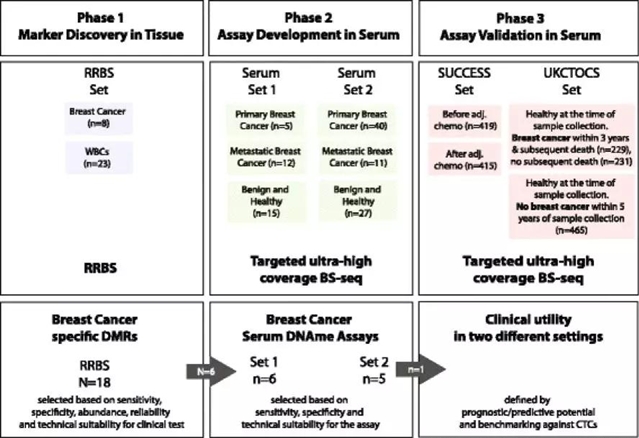|
|
|
|
|
血清DNA甲基化模式用于早期识别弥散性乳腺癌 | Genome Medicine |
|
|
论文标题:Methylation patterns in serum DNA for early identification of disseminated breast cancer
期刊:Genome Medicine
作者:Martin Widschwendter, Iona Evans, Allison Jones, Shohreh Ghazali, Daniel Reisel, Andy Ryan, Aleksandra Gentry-Maharaj, Michal Zikan, David Cibula, Johannes Eichner, Marianna Alunni-Fabbroni, Julian Koch, Wolfgang J. Janni, Tobias Paprotka, Timo Wittenberger, Usha Menon, Benjamin Wahl†, Brigitte Rack† and Harri Lempiäinen†
发表时间:2017/11/22
数字识别码: 10.1186/s13073-017-0499-9
原文链接:https://genomemedicine.biomedcentral.com/articles/10.1186/s13073-017-0499-9?utm_source=other&utm_medium=other&utm_content=null&utm_campaign=BSCN_2_DD_Article_Scinet
微信链接:https://mp.weixin.qq.com/s/RhKOr9levHip7jrnFMoxow
目前,致死性乳腺癌(BC)的治疗监测和早期检测仍然是一项迫切需求。异常循环DNA甲基化(DNAme)模式或提供了一种高度特异性的癌症信号。在一篇发表于Genome Medicine的文章中,来自英国伦敦大学学院的Martin Widschwendter及其团队做了一个假设,即无细胞DNAme标记可预示弥散性乳腺癌的存在,即使在存在大量背景DNA的情况下,依然如此。

研究者们对31个组织采用了简化甲基化亚硫酸氢盐测序(RRBS),基于超高覆盖率的甲基化测序结果,对两个独立的前瞻性血清组进行血清分析(n=110)。他们将总生存和乳腺癌(致死性或非致死性)发生率作为主要终点,通过吉西他滨+多西他赛联合辅助治疗,+扩展的双膦酸盐辅助治疗与监测研究(SUCCESS),在419例乳腺癌患者(辅助化疗前后的标本)和英国卵巢癌筛选协同试验(UKCTOCS)人群队列中的925例健康女性(诊断前标本)中验证了特定片段EFC#93的临床应用。
图:实验设计
研究发现,在组织中共发现18种乳腺癌特异性DNA甲基化模式,研究者们对其中的前6种在血清中进行了进一步检测,并对特异性最高的EFC#93进行了临床验证。对于化疗前的标本,EFC#93是一个独立不良预后指标(死亡风险比为7.689),对死亡风险的预测效果优于循环肿瘤细胞(死亡风险比为5.681)。化疗前标本的EFC#93与循环肿瘤细胞均呈阳性的患者中,超过70%的患者会在5年内复发。化疗后的标本中,EFC#93阳性播散性病变似乎对抗激素治疗有反应。对于在标本捐赠后3~6和6~12个月内被诊断为致死乳腺癌的女性,标本中EFC#93血清DNA甲基化阳性的诊断敏感性分别为42.9%和25%,特异性为88%。相比非致死性乳腺癌,其检测致死性乳腺癌的敏感性高出约4倍。
本研究认为,EFC#93血清DNA甲基化模式检测为转移性乳腺癌早期诊断和治疗提供了一种新工具。尚需要开展相关临床研究来评估在影像学无法检出乳腺癌的情况下,EFC#93阳性女性在乳腺病变出现临床表现之前接受抗激素治疗能否获益。
摘要:
Background
Monitoring treatment and early detection of fatal breast cancer (BC) remains a major unmet need. Aberrant circulating DNA methylation (DNAme) patterns are likely to provide a highly specific cancer signal. We hypothesized that cell-free DNAme markers could indicate disseminated breast cancer, even in the presence of substantial quantities of background DNA.
Methods
We used reduced representation bisulfite sequencing (RRBS) of 31 tissues and established serum assays based on ultra-high coverage bisulfite sequencing in two independent prospective serum sets (n = 110). The clinical use of one specific region, EFC#93, was validated in 419 patients (in both pre- and post-adjuvant chemotherapy samples) from SUCCESS (Simultaneous Study of Gemcitabine-Docetaxel Combination adjuvant treatment, as well as Extended Bisphosphonate and Surveillance-Trial) and 925 women (pre-diagnosis) from the UKCTOCS (UK Collaborative Trial of Ovarian Cancer Screening) population cohort, with overall survival and occurrence of incident breast cancer (which will or will not lead to death), respectively, as primary endpoints.
Results
A total of 18 BC specific DNAme patterns were discovered in tissue, of which the top six were further tested in serum. The best candidate, EFC#93, was validated for clinical use. EFC#93 was an independent poor prognostic marker in pre-chemotherapy samples (hazard ratio [HR] for death = 7.689) and superior to circulating tumor cells (CTCs) (HR for death = 5.681). More than 70% of patients with both CTCs and EFC#93 serum DNAme positivity in their pre-chemotherapy samples relapsed within five years. EFC#93-positive disseminated disease in post-chemotherapy samples seems to respond to anti-hormonal treatment. The presence of EFC#93 serum DNAme identified 42.9% and 25% of women who were diagnosed with a fatal BC within 3–6 and 6–12 months of sample donation, respectively, with a specificity of 88%. The sensitivity with respect to detecting fatal BC was ~ 4-fold higher compared to non-fatal BC.
Conclusions
Detection of EFC#93 serum DNAme patterns offers a new tool for early diagnosis and management of disseminated breast cancers. Clinical trials are required to assess whether EFC#93-positive women in the absence of radiological detectable breast cancers will benefit from anti-hormonal treatment before the breast lesions become clinically apparent.
阅读论文全文请访问:
https://genomemedicine.biomedcentral.com/articles/10.1186/s13073-017-0499-9?utm_source=other&utm_medium=other&utm_content=null&utm_campaign=BSCN_2_DD_Article_Scinet
期刊介绍:
Genome Medicine(https://genomemedicine.biomedcentral.com/,8.898 - 2-year Impact Factor, 8.265 - 5-year Impact Factor) is an open access journal publishing outstanding research in the application of genetics, genomics and multi-omics to understand, diagnose and treat disease. Our publication policy combines selection for broad interest and importance with a commitment to serving authors well.
(来源:科学网)
特别声明:本文转载仅仅是出于传播信息的需要,并不意味着代表本网站观点或证实其内容的真实性;如其他媒体、网站或个人从本网站转载使用,须保留本网站注明的“来源”,并自负版权等法律责任;作者如果不希望被转载或者联系转载稿费等事宜,请与我们接洽。